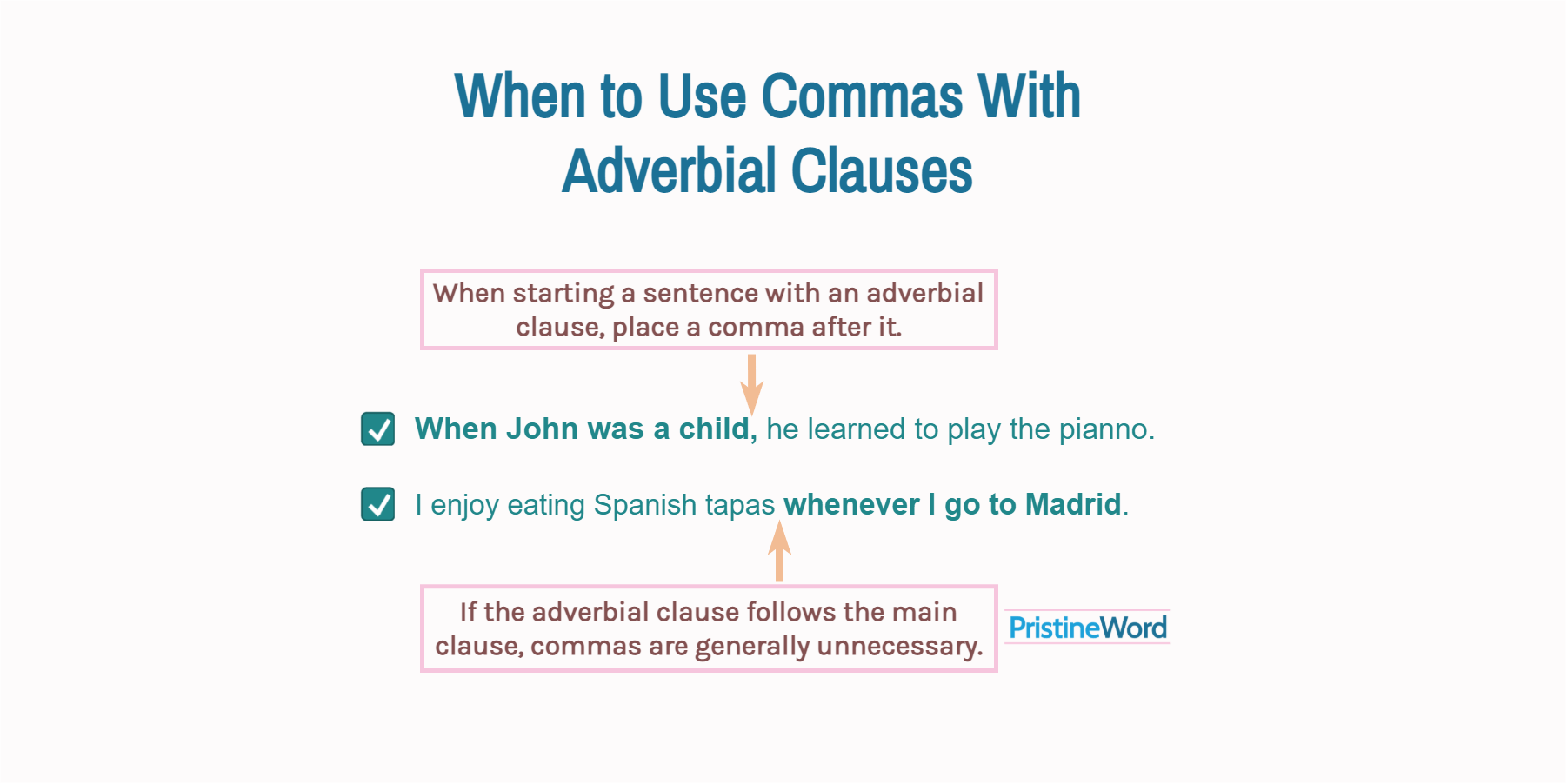When starting a sentence with an adverbial clause, place a comma after it. If the adverbial clause follows the main clause, commas are generally unnecessary.
When starting a sentence with an adverbial clause, place a comma after it.
When John was a child, he learned to play the piano.
When John was a child he learned to play the piano.
If the adverbial clause follows the main clause, commas are typically unnecessary. But there are exceptions.
I enjoy eating Spanish tapas whenever I go to Madrid.
In mid-sentence, an adverbial clause can be used to add nonessential information or interrupt the sentence flow. In such a situation, it should be surrounded by commas.
Mary learned Spanish, when she was a child, because her father is Mexican.
Contents
1. Introduction to Adverbial Clauses
An adverbial clause is a group of words (containing a subject and a verb) that plays the role of an adverb by providing a description of where, when, how, or to what extent something happens.
When I travel to Thailand, I enjoy visiting Buddhist temples.
Adverbial clauses are dependent clauses that are always introduced by a subordinating conjunction, such as "when", "because", "since", "although", "while", "until", "if", "unless", etc. The subordinating conjunction always comes before the adverbial clause.
Olivia went to a restaurant because she was hungry.
But the adverbial clause itself can precede or follow the main clause, so you can say:
If I were you, I wouldn't worry about that issue.
I wouldn't worry about that issue if I were you.
2. When to Use a Comma Before or After an Adverbial Clause
When starting a sentence with an adverbial clause, add a comma after it.
Although the salary was low, Emma decided to accept the job offer.
Although the salary was low Emma decided to accept the job offer.
It is possible to drop the comma if the clause is clear, quite short, and does not require a pause.
Wherever she goes trouble seems to follow.
If the adverbial clause follows the independent clause, the comma before the subordinating conjunction is generally unnecessary.
We will wait here until you come back.
3. Exceptions
There are exceptions to this convention of not using commas when the adverbial clause follows the main clause.
3.1 'Although', 'Even though', and 'Whereas'
When there is a strong contrast between two clauses, place a comma for clauses introduced by whereas, although, though, or even though.
Peter was sad, although he had won a Nobel Prize.
3.2 Setting off Nonessential Clauses
Use commas to set off nonessential clauses, that is, clauses that can be used as an aside.
I rarely eat fried food, although I like it, because it's unhealthy.
Note that we can remove the clause "although I like it" without changing the essential meaning of the sentence.
I rarely eat fried food because it's unhealthy.
By contrast, if we remove the clause "because it's unhealthy" from the first sentence, the adverbial clause "although I like it" becomes essential and the comma is not required.
I rarely eat fried food although I like it.
But you can add a comma to signal that the adverbial clause does not define—or to introduce it as an afterthought.
I rarely eat fried food, although I like it.
In the middle of a sentence, adverbial clauses generally function as interrupters and should be surrounded by commas.
I did succeed, because my efforts were rewarded, and my boss was impressed with my work.
3.3 Comma Before Because
Place a comma before "because" only if needed for clarity.
I didn't do the job, because I was busy. (I didn't do the job due to the fact that I was busy.)
I didn't do the job because I was busy. (The reader is liable to think that being busy was not the reason for not getting the job done.)

